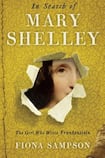
For 200 years, the freewheeling, chaotic lives of the Romantic poets, replete with sexual emancipation, elopement, teenage pregnancies and tragic death, have provided biographers with abundant riches. Mary Shelley's illustrious parentage – her mother was the pioneering feminist writer Mary Wollstonecraft, and her father political philosopher William Godwin – combined with her own literary achievements has ensured that her life is more comprehensively documented than most women of the era. In the latest addition to this canon, In Search of Mary Shelley: The Girl Who Wrote Frankenstein, writer and poet Fiona Sampson points out: "It is the daughter of those famous thinkers that Percy [Bysshe Shelley] has fallen in love with."
Sampson, who was editor of Poetry Review from 2005 to 2012, and is professor of poetry at the University of Roehampton, has an infectious curiosity for her subject and explores her life using motifs from literature, music and art. Astonishing scenes are laid before the reader in the manner of vivid tableaux: Mary, aged eight, hiding behind the sofa with her half-sister and begging to be allowed stay up late to hear Coleridge read to the end of The Rime of the Ancient Mariner; Mary, aged 16, sick and pregnant, lying in a boat with her head resting on Shelley's chest as a storm rages around them. A born outsider whose arrival killed her brilliant mother, her childhood anxieties prompt a letter from her father, sent from Dublin, assuring her that he has no intention of giving her away.
Spectacular vernacular
Adopting an unconventional approach, Sampson writes in the vernacular and uses the present tense: "Building a life together isn't heat of the moment stuff," she remarks of Mary's early months with Shelley. Mary is "four months gone" in pregnancy. They live "hand-to-mouth". Mary is Shelley's "enabler". Her father is "a failure with the ladies" and "comes on heavily" to one. The celebrated sojourn at the Villa Diodati, which culminated in Frankenstein, is described as a "sleep-over".
Although this might grate, such accessible language gives Sampson’s writing a compelling immediacy. Eyewitness accounts, letters and journal extracts are woven seamlessly into her narrative, while capsule biographies and historical detail provide context. On occasion, she indulges in unfettered speculation, exploring no less than eight possible reasons why Shelley, a lifelong promoter of free love, might have encouraged Mary to sleep with other men.
Sampson, who is Mary’s staunch defender, insists that this girl was “ground down by the feckless Shelley gene”. Aged 16, unmarried and pregnant with the first of five children she will carry for him, she walks 700 miles from France to Switzerland to set up home with her lover and her stepsister, who occupies far too much of his attention. Later he invites his estranged wife to join them. She writes one of literature’s most enduring masterpieces, only to have it attributed to her now-husband time and time again. At 21 she buries her third child, her beloved “Wilmouse”. By the time she is 24, she is living with her openly hostile husband in a “suffocating, often hysterical, psychic atmosphere”. He is marauding around town with a band of friends who have formed the Corsair Club, which, as Sampson points out, “sounds as ridiculous as a children’s TV cartoon”. Little wonder Mary battles depression and writes in her journal, after Shelley has drowned: “All was over – all quiet now.”
Enduring masterpiece
The Mary who endures is Mary Shelley the writer, whose literary fame eclipsed her husband’s for a time. As Sampson points out, “in an era when women have almost no opportunity to earn their own keep, without her husband she faces financial ruin, or at best dependency on the whim of hostile in-laws”. Although her father-in-law forbids her from using the Shelley name, or documenting any aspect of his son’s life, she succeeds as “a literary freelancer”. It is Lord Byron, her unlikely champion, who treats her as an intellectual equal and sends literary work her way, helping her to support her son through university. She ends her days in poor health, living in the house where Shelley was born.
Sampson includes a fascinating exploration of Mary’s sexuality. She enjoyed relationships, some of them serious, after her husband’s death, and she exchanged intimate letters with several women. “Where Mary stands on the spectrum of sexual orientation may not be entirely clear, even to herself,” Sampson concludes. A complex woman who did well to survive her encounter with the chaotic world of Percy Bysshe Shelley, it is to her great credit that Mary is remembered primarily as a writer. As Sampson so eloquently puts it in her fascinating and ambitious biography: “Above all, she forced open the space for herself in which to write; and it is on the page’s white spaces, its “vast and irregular plain of ice”, that we do best to pursue her.”
- Eleanor Fitzsimons is a writer and researcher. In 2013 she won the Keats-Shelley Prize. She is the author of Wilde's Women and is working on a biography of E Nesbit










